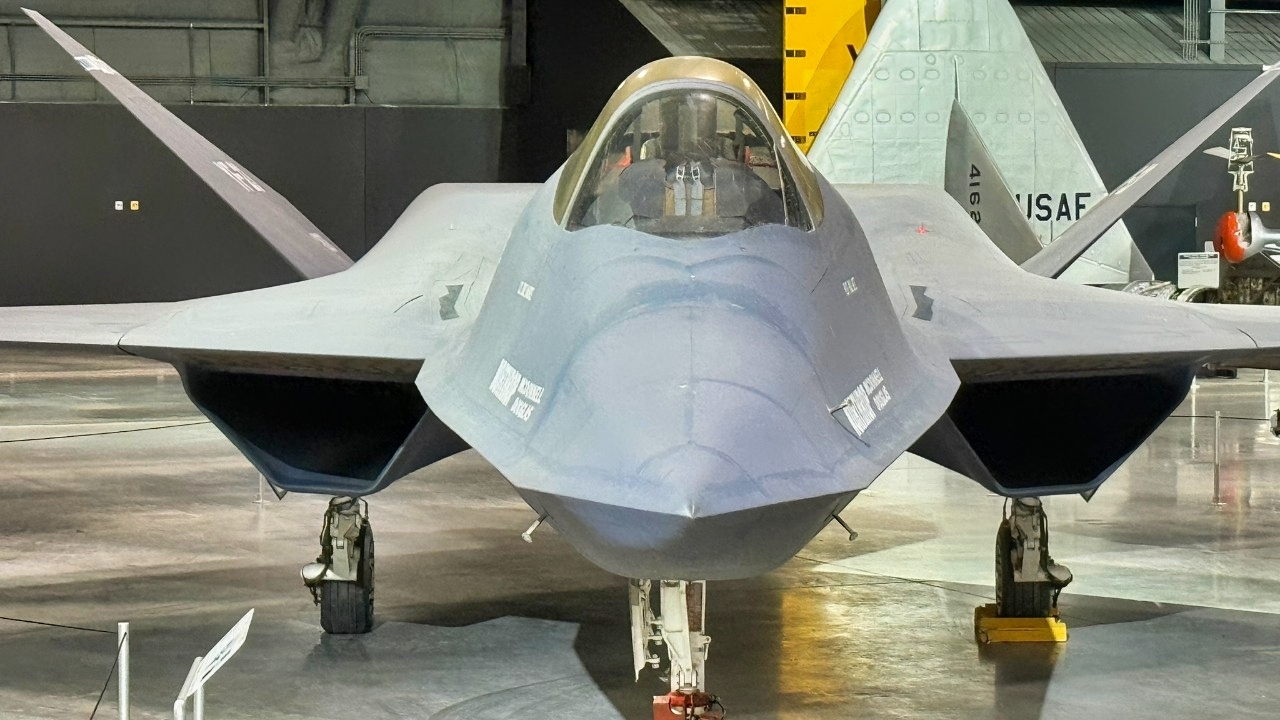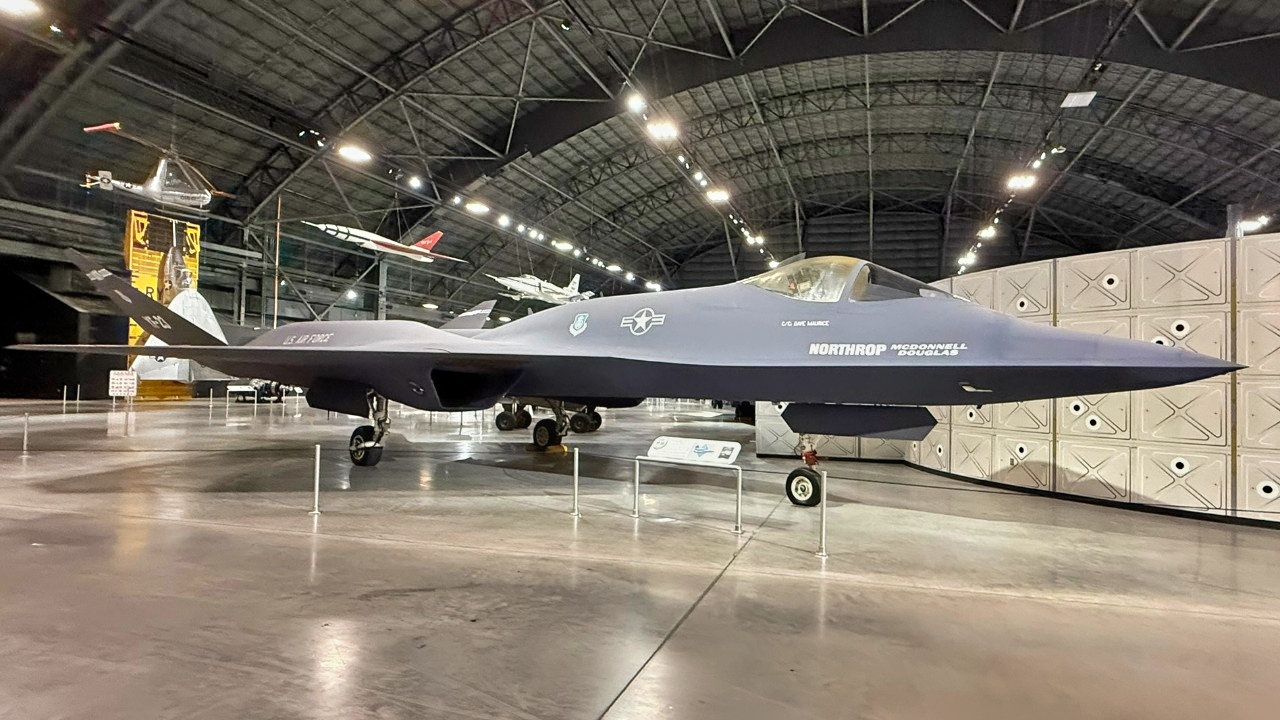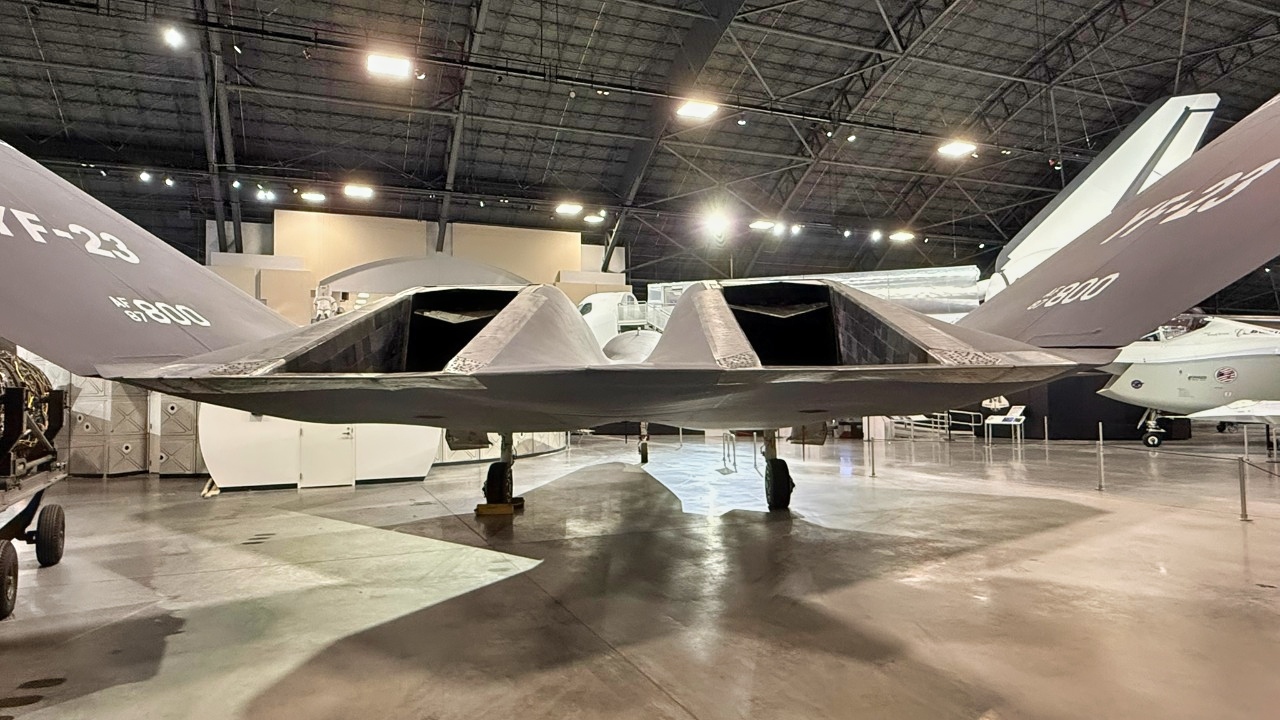Key Points and Summary on the YF-23 – The Northrop YF-23, though arguably faster and stealthier than its rival, lost the Advanced Tactical Fighter competition to the Lockheed YF-22 in 1991, a decision that still sparks debate today.
-Critics argue the Air Force was swayed by the YF-22’s superior agility in a dogfight, a focus of the “fighter mafia” at the time, and by Lockheed’s superior “salesmanship.”

YF-23 at U.S. Air Force Museum Photo by NSJ. Taken on 7/19/2025 by Harry J. Kazianis.
-The YF-23, which was the only prototype to actually supercruise in the fly-off, may have been the more technologically advanced platform, a forgotten “what if” in the history of American air power.
-This essay includes original photos and video from a recent trip to the U.S. Air Force Museum in Dayton, Ohio, where we were inches from the YF-23.
The YF-23 Stealth Fighter Explained
The Northrup McDonnell-Douglas YF-23 Advanced Tactical Fighter (ATF) is almost forgotten by many, thanks to the F-22 Raptor and how dominant it is. This other prototype design participated in the 1991 fly-off between the two competing designs.
The loser, some would say regrettably – of the “demonstration/validation competition” between this aircraft and the Lockheed-Boeing-General Dynamics YF-22 design.

YF-23 National Security Journal Photo. Taken by Harry J. Kazianis at U.S. Air Force Museum on 7/19/2025.
The “winner” of the competition was given the contract to proceed to full-scale development and production.
This process would turn one of the “YF” aircraft into “F” models, or fully-developed testbeds that would be flown to validate the final validated design before the plane proceeded on to series production.
With the increasing discussion today about the current NGAD program, the YF-23, which slipped into semi-oblivion and was almost forgotten about, has seen a resurgence in interest in its design.
Some claim that aspects of its design have been forgotten, but today’s designers of modern fighter would do well to take a second look at.
YF-23: Could It Beat the F-22?
One of the main differences between the two prototypes was that overall, the “YF-23 was faster and stealthier, but the YF-22 was rated as being more agile.”
The YF-23 also “showcased better range, higher ceiling, and superior stealth features,” reads another history of the fly-off. “However, during flight demonstrations, the YF-22 excelled by performing more aggressive maneuvers and missile launches.”
It was the YF-22 being more of a “fighter pilot’s airplane” is what impressed the USAF, said one long-time US observer of the various stealth fighter programs over the years.

YF-23 National Security Journal Photo. Taken by Harry J. Kazianis at U.S. Air Force Museum on 7/19/2025.
“The objective of the ATF program was to have a fighter that was going to be stealthy enough to remain unseen by enemy fighter radars and air defense systems and then to be able to turn and run away fast enough to survive,” he said.
“What no one wants to admit is the ‘white-scarf, inside the furball’ fighter mafia still reigned supreme in that time, an observation echoed by test pilot Paul Metz, one of the few to ever fly both aircraft.

YF-23 Fighter at USAF Museum. Image by Harry J. Kazianis/National Security Journal.
“Northrop’s YF-23 team was made up of brilliant engineers,” as he recalled, and Metz describes them as beyond compare, but he also saw that they “thought and spoke almost exclusively in engineering terms.”
Meanwhile, he continued, “Lockheed infused far more marketing, salesmanship, and pizazz—’lasting impressions’ as he describes”—into their YF-22 flight demonstration program. “They fundamentally understood how to sell their aircraft and how ‘showmanship’ heavily impacts the acquisition decision-making process. Northrop didn’t and that fact may have proven fatal for the YF-23.”

YF-23 National Security Journal Photo. Taken by Harry J. Kazianis at U.S. Air Force Museum on 7/19/2025.
Why Requirements Matter
More than 30 years back is a long time ago, so saying today that the YF-23 is a better fit for the air combat environment in 2025 is more than a bit of hindsight.
However, one of the well-known writers about stealth designs in the aviation community is James Stevenson, the author of an exhaustive book on the ill-fated A-12 stealthy carrier attack aircraft. He spoke to me about some unknown details of the actual fly-off.
“The purpose of the fly-off that selected the YF-22 was supposed to validate which design most comprehensibly met all the major requirements. These were stealth, an AESA radar and the ability to supercruise,” he stated.
“But the YF-22 demonstrated none of these. Neither the stealth characteristics nor the radar were prepared enough for demonstration. Of the two aircraft, only YF-23 ever supercruised and that was the prototype with the GE F-120 engine – the engine that lost in the competition to the Pratt & Whitney F119 – even though it demonstrated better performance.
The USAF in essence, selected an empty prototype – an “aerodynamic paint job,” as Stevenson puts it – “and then said to the contractors ‘now go develop the aircraft’”.
No one would say that the F-22 is not an impressive-performing aircraft. Pilots who have flown it say that they “like the situation of not being able to be seen on radar and that it is a marvellous machine.”
MORE – 7th Generation Fighters are Possible
But the aircraft is set to begin its sunset years in 2030, while aircraft designed more than 30 years earlier, like the F-15 continue in production and are still in considerable demand.

YF-23 National Security Journal Photo. Taken by Harry J. Kazianis at U.S. Air Force Museum on 7/19/2025.
Had the YF-23 been the winner, it might be an even greater asset to the U.S. Air Force.
But looking back, as one former fighter pilot friend reminds me, “does not do you any good in this business.”
THOSE 4 Words: Might Have Been Better!

Back of YF-23 Fighter. Image Credit: National Security Journal.
About the Author: Reuben F. Johnson
Reuben F. Johnson has thirty-six years of experience analyzing and reporting on foreign weapons systems, defense technologies, and international arms export policy. Johnson is the Director of Research at the Casimir Pulaski Foundation. He is also a survivor of the Russian invasion of Ukraine in February 2022. He worked for years in the American defense industry as a foreign technology analyst and later as a consultant for the U.S. Department of Defense, the Departments of the Navy and Air Force, and the governments of the United Kingdom and Australia. In 2022-2023, he won two awards in a row for his defense reporting. He holds a bachelor’s degree from DePauw University and a master’s degree from Miami University in Ohio, specializing in Soviet and Russian studies. He lives in Warsaw.
More Military
The U.S. Navy’s Submarine Crisis Is Real











Tyler Durdin
July 18, 2025 at 10:01 am
In the words of Tom Cruise “Its not the plane, it’s pilot” when it comes to a dog fight in the air.
Pingback: Links 7/19/2025 | naked capitalism
Pingback: Links 7/19/2025 | naked capitalism -
jose ramirez
July 19, 2025 at 11:59 am
In the words of modern pilots: “ what’s a dog fight”?
Peter Lithgow
July 20, 2025 at 10:24 am
Not clear what 4 words were actually being referred to so pretty poor title to the article.
Barry Hill
July 21, 2025 at 10:43 am
Impressive, but, now….let’s see if all this data, details, and plans can be secured and private…
Curtis Conway
July 26, 2025 at 5:43 pm
The YF-23 Black Widow prototypes met all test requirements, and squarely beat the YF-22 in all areas of the competition. Now that we are in the Pacific those areas that the YF-23 excelled in are badly needed, and the F-22 Raptors are not only not up to the task, but starting to show their age/limitations even in the advanced/enhanced model. Sad state of affairs.
The YF-23 Prototypes met most of the 6th Gen criteria and could easily be upgraded with the advanced engines, and improved versions of Generation 5 capability. Perhaps this is what the new F-47 and F/A-XX will look like. I sure hope so. We are out of time, a day late, and a dollar short.
Curtis Conway
July 26, 2025 at 5:49 pm
How ‘short sighted’ the USAF was to choose the YF-22. Aggressive maneuvers MEANS NOTHING when engaging targets in Beyond Visual Range engagements. That capability was already being enjoyed by U.S. fighters at the time of the selection with intelligence assessments advising that BVR engagements would become more the norm. Who is leading this Goat Rope anyway. I hope they got their cut of the profits . . . for the U.S. has not been served well with this decision. We didn’t build the 500 required which would have brought down the cost per unit considerably.
Curtis Conway
July 26, 2025 at 5:51 pm
How ‘short sighted’ the USAF was to choose the YF-22. Aggressive maneuvers MEANS NOTHING when engaging targets in Beyond Visual Range engagements. That capability was already being enjoyed by U.S. fighters at the time of the selection with intelligence assessments advising that BVR engagements would become more the norm. Who is leading this Goat Rope anyway? I hope they got their cut of the profits . . . for the U.S. has not been served well with this decision. We didn’t build the 500 required which would have brought down the cost per unit considerably.
Swamplaw Yankee
July 28, 2025 at 1:24 am
The inner beltway allocates cash in mysterious ways. Agreed? So, the USA is not the exclusive jurisdiction of high level stealth air frames.
In 2025 any air frame that the touts pr must be sent to the Ukrainian front. That is the prime test field.
One notices that air frames that get tout pr in this site refuse to be revealed on the Ukrainian front lines. For example, the IDF chicken dance whenever their big air frame might even be considered for a visit to the Ukrainian front!
The talk is that the need for post F-35 air frames is very sketchy. This need for Post F-35 technology must be debated. Can even the F-35 survive “Low air” drone technology? Can “Low air” drone technology of 2028-29 completely eliminate the cost/benefit of all this 7th – 8th generation speculation? What is the reality + what op-ed writer is hitting this cognitive target?
Unless those PR claims of F-35 IDF air frames are tested in Ukrainian air front lines, the speculators will hack keyboard as they are not at the race track and have to put their own money on their guesswork. -30-
Kevin Kehoe
September 5, 2025 at 2:33 pm
Your bud is wrong about looking back. It’s getting trapped there that’s the problem. If cannot see where you come from, you will repeat the same damn mistakes
Brimmstone
September 20, 2025 at 11:36 am
I worked at Northrop back during this time, I remember us winning one of the two down-select spots (along with Lockheed), the rollout, and the the day of the final contract award announcement – and 30 years later it still stings! Oh what could have been. I can only hope that the F/A-XX is awarded to Northrop and that we can see THE it’s YF-23 DNA.